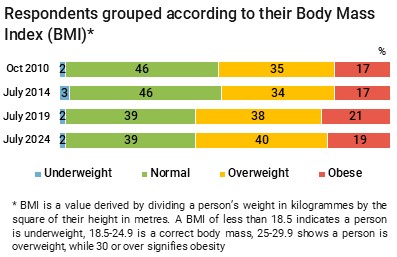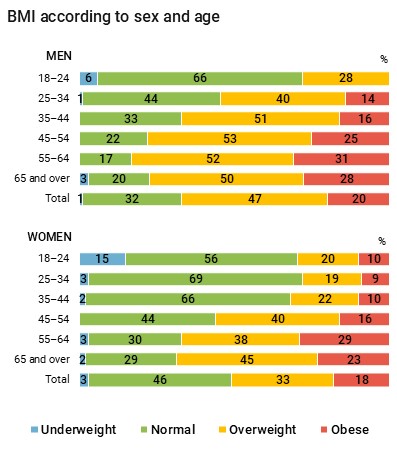19/2024
2024-09-30
Polish People’s BMI
Respondents were asked to give their height and weight, from which it was then possible to calculate their Body Mass Index (BMI). The calculations are based on people’s answers and not on objectively measured parameters, thus they may not be a true reflection of reality, particularly regarding weight, which is a sensitive issue for some people. Keeping that in mind, it can be said that six out of ten adults (59%) weigh more than they ought to: two fifths (40%) are overweight and one fifth (19%) are obese. The BMI of two fifths of those surveyed (40%) shows their weight to be within the normal range. A very few – two in a hundred (2%) were found to be underweight. Not much has changed since the previous survey five years ago, apart from a minimal movement of people from the obese to the overweight group. On the other hand, both these two surveys clearly differ from the previous two in 2010 and 2014, when Polish adults were generally lighter (their weight more often fell within the correct limits and they were less frequently found to be overweight or obese).

|
People’s BMI is strongly correlated with their age. In general, young adults tend to be in the normal range then, as they age, they are more likely to be overweight or obese. This process, however, runs differently for women and men. Not only are women more likely than men to be in the normal range, they more often stay there as they age. This weight difference between the sexes is greatest among 35–44-year-olds (33 percentage points), but is still pronounced among 25–34-year-olds (25 points) and 45–54-year-olds (22 points). It is only in the youngest age group (18–24) that the percentage of men within the normal range is higher than the percentage of women (66% as against 56%). It is also worth noting that in this age group being underweight is more characteristic of women (15% as against 6% for men). The risk of becoming overweight or obese is greatest for men aged 55–64 (with 83% showing a raised BMI) and women over 54 (of whom 67–68% of those surveyed are overweight or obese). Additionally, obesity is particularly likely in the 55–64 age group, regardless of sex (31% for men, 29% for women).

|
More on this subject in the CBOS report.
This ‘Current Events and Problems’ survey (411) was conducted using a mixed-mode procedure on a representative sample of named adult residents of Poland, randomly selected from the National Identity Number (PESEL) register. Respondents independently selected one of the following methods: Computer Assisted Personal Interview (CAPI); Computer Assisted Telephone Interview (CATI), respondents receiving researchers’ telephone numbers in an introductory letter from CBOS; Computer Assisted Web Interview (CAWI), where respondents filled in the online questionnaire independently, gaining access by means of a login and password provided in an introductory letter from CBOS. In all three cases the questionnaire had the same structure and comprised the same questions. The survey was carried out between 4 – 14 July 2024 inclusive on a sample of 1076 people (61.9% using the CAPI method, 23% CATI and 15.1% CAWI). CBOS has been conducting statutory research using the above procedure since May 2020, stating in each case the percentage of personal, telephone and internet interviews.





